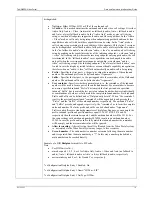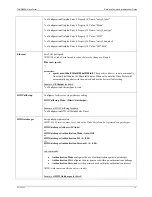
TANDBERG Video Portal
Data port Command Interface User Guide
distinguished:
•
Net type -
Either H324m, H323 or SIP of the outbound call.
•
AV mode –
This mode determines the outbound audio and video call settings. It is either
Audio Only, Audio + Video, Auto(matic) no fallback to audio, Auto + fallback to audio
and Auto + always fallback to audio. In the “Audio Only” mode a voice call is being
setup, even when all endpoints support both audio and video capabilities. In the “Audio
+ Video” mode a call is only being setup when endpoints support both audio and video
capabilities and a call with both these capabilities can be setup. In the “Auto” mode a
call is being setup according to the capabilities of the endpoints. Of the latter, 3 versions
can be distinguished: no fallback to audio, fallback to audio or always fallback to audio.
In the “no fallback to audio” case either an “audio + video“ or an audio only call is being
setup, depending on the capabilities choice of the initiating endpoint, i.e. when an “audio
+ video” call is being setup, whereas the receiving endpoint only supports audio, the call
is terminated. In the “fallback to audio” case capabilities can be changed to an audio
only call when the receiving endpoint supports only audio, even when an “audio +
video“ call is being setup by the initiating endpoint. The “always fallback to audio” case
is used in case the telephony switch interferes or cannot handle capability renegotiation,
therefore when an “audio + video” call fails automatically an audio call is being setup.
•
Prefix –
Specifies the first part, i.e. the part preceding the remainder, of the outbound
number. The outbound prefix can be defined under “Arguments”.
•
Suffix –
Specifies the last part, i.e. the part appended to the remainder, of the Outbound
number. The outbound suffix can be defined under “Arguments”.
•
Use remainder -
Specifies whether a particular part, i.e. the remainder, of the inbound
number will be used to form a part of the outbound number. For a remainder to become
non-zero a specified inbound “Prefix” has to match the first part and/or a specified
inbound “Suffix” has to match the last part of an inbound number, however individually
or combinations of both never fully match the complete inbound number. Both inbound
Prefix and Suffix can be defined under “Dialplan entry details”. When “Use remainder”,
is active the previously mentioned “remainder” will be appended to and precede the
“Prefix” and the “Suffix” of the outbound number, respectively. The outbound “Prefix”
and “Suffix“ precede and append, respectively, the “remainder” as to form the complete
outbound number. The latter prefix and suffix can be defined under “Arguments”.
Prefixes and suffixes are standard parameters of dial plans. Suppose, as an example, the
prefix, inbound, prefix and postfix numbers equal 1234, 9876154, 9876 and 54
respectively then the remainder equals 1 and the outbound number will be 12341. For
the same settings with an inbound number 9876254 results in an outbound number
12342. In case the prefix and/or suffix fully match the inbound number the remainder
will be empty and the useremainder value will be ignored.
•
Allow forwarding -
After call setup the call is offloaded from the Video Portal system,
i.e. not routed via the Video Portal system any longer, to free resources.
•
Use sub number -
The sub number is a number extension following the main number
and is separated from the main number by a "*". In this way a number plan behind a
main number can be reached directly.
Example of a DID
Dialplan
for mobile to SIP calls:
Note:
•
For DID ServiceId = 1.
•
avmode equals 1, 2, 3, 4 or 5 for Audio Only, Audio + Video and Auto (no fallback to
audio), Auto + fallback to audio or Auto + always fallback to audio, respectively.
•
useremainder equals 0 or 1, for No and Yes, respectively.
*c xConfiguration Dialplan Entry 1 Enabled: On
*c xConfiguration Dialplan Entry 1 Name: "H324m - SIP"
*c xConfiguration Dialplan Entry 1 NetType: H324m
D1392602
10











































